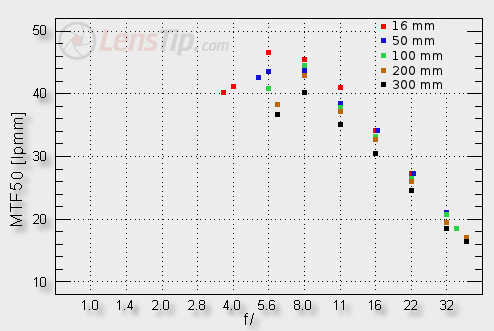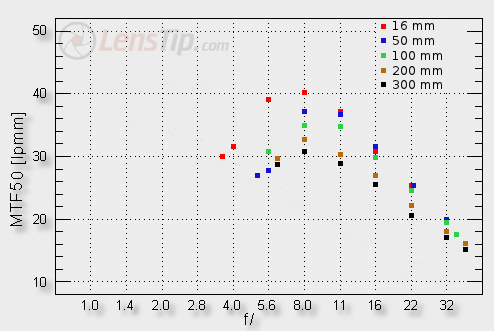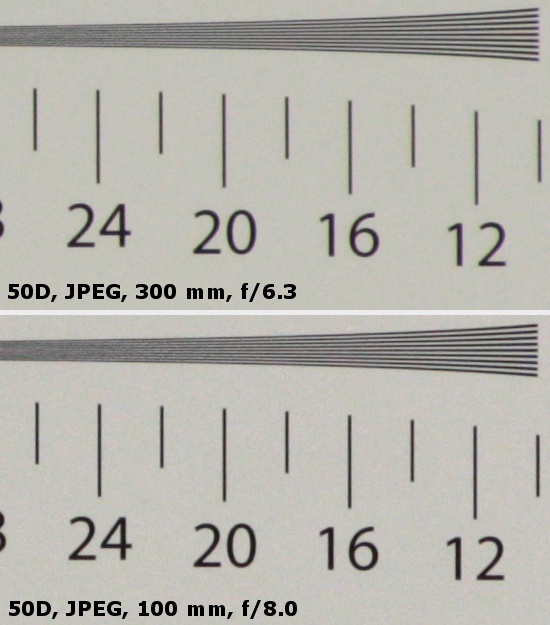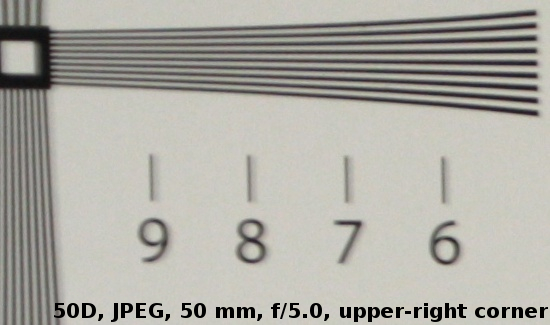Tamron 16-300 mm f/3.5-6.3 Di II VC PZD MACRO
4. Image resolution
Let’s see how the tested lens compares here, checking first the frame centre.

Please Support UsIf you enjoy our reviews and articles, and you want us to continue our work please, support our website by donating through PayPal. The funds are going to be used for paying our editorial team, renting servers, and equipping our testing studio; only that way we will be able to continue providing you interesting content for free. |
- - - - - - - - - - - - - - - - - - - - - - - - - - - - - - - - - - - - - - - - - - - - - - - -
You can notice at once that, in the case of the tested lens, there will be no resolution records. The best results the Tamron reaches at the wide angle, on stopping down to near f/5.6 – it can get to 46 lpmm there. However you should emphasize the fact that nobody expected the lens to have record performance because the best results appear near f/4.0 aperture, providing that a lens is already stopped down by about 2-3 EV. The Tamron, being slower, doesn’t even feature f/4.0 for most of its focal range so not only it has to fight different optical aberrations but it also faces diffraction.
You have to be honest – the results in the frame centre are good, especially when you take into account what focal range you deal with and you notice that at no focal length the lens descends below a quite decent level of 35 lpmm . It means the lens performs as it is supposed to do and it really deserves our recognition. It will be a very useful tool for any amateur photographer who cares to take it out for a walk or a trip.
The situation changes a lot when you look at the edge of the frame.

The 16 mm focal length still looks decent - it is true by f/3.5-4.0 you are below the decency level but the performance improves very quickly on stopping down so by f/8.0 the MTFs exceed a good level of 40 lpmm. The biggest crisis – something we expected all the time in a megazoom – you encounter at 50 mm. In the case of that focal length the vicinity of the maximum relative aperture is simply weak (and you can see it pretty clearly in one of the crops, shown by us below); only after employing f/8.0 the image becomes acceptable. Passing to the longer end the image at the maximum relative aperture is no longer as weak as at 50 mm but still it can be hardly called decent. At 300 mm you simply cannot get sharp images on the edge of the frame, no matter what focal length you use. This is the price of experimental parameters and you must be aware how much you have to pay.
As we already mentioned in this chapter, below you can find crops taken from JPEG files, saved along RAW files. The first panel shows images from the frame centre and the last – the appearance of the upper left-hand corner of the frame at 50 mm.
 |
 |






